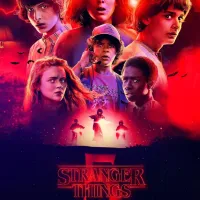A Journey Beyond the Ordinary
Stepping into the universe of Stranger Things is like entering a portal into an alternate reality where the mundane boundaries of suburban life dissolve into a fantastical territory full of unexpected wonders. As an experienced film enthusiast who has spent years exploring both mainstream blockbusters and hidden indie gems, I found that this series pushes the envelope in ways that few contemporary narratives dare to approach. It’s not merely a nostalgic tribute to the 1980s; it’s a story that unfolds layer by layer, inviting the audience to watch characters navigate personal struggles, mysterious realms, and the labyrinth of an unseen world that exists alongside our own.
The creativity behind Stranger Things is instantly immersive. Every scene has been meticulously designed to evoke emotion and reflection, bridging science fiction with heartfelt drama. The careful interplay of suspense, humor, and tender moments creates a cinematic tapestry that is as unpredictable as it is engaging. One cannot help but be drawn into the vibe of a bygone era while simultaneously experiencing the thrill of modern storytelling.
An Intricate Tapestry of Narrative and Atmosphere
The series employs a unique narrative structure, intertwining multiple story arcs that converge in surprising ways. Here, plot lines that appear disconnected early on reveal their congruence in the later episodes, creating a layered storyline that demands careful attention. The intricate web woven throughout the series compels viewers to watch every trailer, scrutinize every detail, and uncover hidden meanings that speak to themes of friendship, resilience, and the inevitable confrontation with one’s past.
The show’s aesthetic is equally compelling. The production design is a loving homage to the era it seeks to capture. From the clothing and hairstyles to the decor and ambient landscapes, every element has been crafted to evoke a sense of nostalgia while still resonating with a modern audience. The balance between realism and surreality is maintained beautifully, and it is this fine balance that permits the audience to stream the series with an open mind and a sense of artistic wonder.
The Mechanics of Suspense and Creativity
Stranger Things distinguishes itself not just through evocative visuals but also by its innovative narrative mechanics. The dynamic pacing of the series, where moments of high tension are interspersed with reflective pauses, creates a natural rhythm that feels both soothing and electrifying. The soundtrack—an eclectic mix of haunting melodies and upbeat motifs—reinforces the show’s atmosphere, inviting viewers to download the emotional resonances of each scene into their own memory banks.
Unlike the predictable paths often encountered in genre flicks, this narrative takes risks. Characters are not caricatures or simple archetypes; they are multi-dimensional, evolving as the story unfolds. The voice of youth is particularly noteworthy here: it conveys both vulnerability and wisdom beyond its years. It is a creative decision that stands out in the modern television landscape, where superficial heroics are often preferred over genuine character evolution.
Characters: The Heartbeat of the Series
The ensemble cast delivers outstanding performances that elevate every aspect of the series. Each character, from the determined protagonists to the enigmatic supporting cast, brings forth a relatable quality that anchors the supernatural elements in a deeply human reality. The efforts of the cast are palpable; their ability to convey complex emotions without resorting to theatrical overstatement has redefined the expectations of what a well-rounded character should be. Observing the show, one may not only watch the unfolding drama but also feel as though they are accompanying friends on a daunting yet exhilarating journey.
There is a palpable chemistry in every interaction, whether it be the playful banter among younger characters or the intense, charged moments that reveal hidden vulnerabilities. The series effortlessly bridges the gap between youthful exuberance and the wisdom of experience, capturing the imagination of both young and mature viewers alike. It encourages the audience to stream beyond the surface and download pieces of its narrative into their own lives.
A Fresh Perspective on Familiar Grounds
The narrative of Stranger Things serves as a vessel to explore themes that are not typically ventured in mainstream storytelling. As elements of the supernatural mingle with everyday life, this series offers a fresh perspective on the challenges of growing up, the terror of isolation, and the inescapable pull of curiosity. It stands as a testimony to the idea that even in times of great uncertainty, there always remains a spark of hope—a notion that is both refreshing and liberating.
What is particularly commendable is how the series manages to remain accessible while still embracing a hint of melancholy. The juxtaposition of joy and sorrow not only adds depth to the narrative but also makes it an ideal piece to download into the collective cultural consciousness. Paradoxically, the show delivers unsettling moments in a manner that feels both organic and necessary, reminding viewers that complexity is seldom confined to the realms of fiction alone.
Production Excellence and Attention to Detail
Every element of Stranger Things is a testament to the prowess of modern production. It’s a meticulously crafted narrative that combines nostalgic 1980s influences and contemporary production techniques to produce a series that is as visually arresting as it is intellectually stimulating. The meticulous set design, coupled with cinematic camera work, encourages viewers to explore the unnoticed details—a subtle nod to those who enjoy the thrill to stream every scene multiple times and to discover nuances that are often unblocked from immediate perception.
The innovative use of lighting and shadows does more than simply set a mood; it acts as a silent narrator, guiding the audience through moments of suspense and revelation. This is complemented by a keen sense of rhythm and pacing that ensures the series never loses its narrative momentum. In this way, the series not only invites its audience to watch and stream but also challenges them to appreciate the artistry behind every frame. The creative decision to fuse a hauntingly realistic landscape with fantastical elements helps the series maintain an heirloom quality—one that will undoubtedly be appreciated by generations to come.
The Intersection of Entertainment and Innovation
Stranger Things represents the intersection of classic storytelling and modern innovation. It encompasses a narrative that is as expansive as it is intimate, making it one of the most enduring and memorable series in recent cinematic history. Its ability to blend the supernatural with the everyday creates a refreshing divergence from formulaic plots, offering viewers an opportunity to immerse themselves in an experience that evolves with every episode.
One of the most enthralling aspects is how the series seamlessly bridges the gap between a mythic quest and a deep dive into one’s personal history. Every plot twist feels meticulously orchestrated to challenge the status quo and to question what we deem possible within the confines of our small realities. To watch this series is to embark on a journey that feels simultaneously personal and universally resonant—a duality that is rarely captured in conventional narratives.
The capacity to stream this narrative online gives a modern twist to the classic cinema-going experience. Whether viewed on a grand television screen in a dimly lit room or on a mobile device during a quiet evening, every frame of Stranger Things is a portal to a richer, more mysterious world. Furthermore, the series offers options to download episodes for offline viewing, a feature that enhances its accessibility and cements its status as an engaging piece of art.
Layered Themes and Reflections on Reality
At its core, Stranger Things encapsulates a blend of layered themes that invite viewers to explore the boundaries between reality and imagination. The narrative is replete with metaphors and symbolic imagery, making it much more than a superficial exploration of the uncanny. In fact, every symbolic element, every atmospheric detail, encourages a deeper understanding of the mechanisms of human memory, the complexities of time, and the omnipresent influence of otherworldly forces.
The series frequently delves into the delicate balance between the known and the unknown, which is subtly mirrored in the personal journeys of its characters. It challenges us to download into our minds the notion that ambiguity is not something to be feared but rather embraced as part of the human condition. Watching each episode, one is reminded that the messy intricacies of life, with all its uncertainties, serve as a profound source of inspiration naturally waiting to be discovered.
This exploration of intertwined destinies is particularly significant in today’s age of fractured narratives and segmented identities. Stranger Things manages to convey that even in fragmented lives, there exists a shared tapestry connecting every individual to the greater, often inexplicable, rhythm of life. The series calls on its audience to look beyond the surface, to tap into a repository of hidden connections, and to consider that every moment has the potential to resonate on multiple levels.
Conclusion: A Masterpiece of Modern Storytelling
In summation, Stranger Things is more than just a series—it is a richly layered experience that embodies the unyielding spirit of storytelling innovation. As a film enthusiast, I appreciate the bold risks the series takes, weaving a narrative that is both unpredictable and profoundly reflective. It is a masterpiece that continuously invites viewers to watch, stream, download, and even share the experience with friends who are equally intrigued by the magic of cinematic excellence.
Whether accessed online or through platforms that offer episodes to stream in high-definition, every moment spent with Stranger Things is a discovery. Its narrative structure, compelling characters, and innovative visual style create a production that is both timeless and entirely of its time. Ultimately, the series challenges conventional storytelling, beckoning audiences to explore uncharted creative territories while keeping a discerning eye on details that make every viewing unique.
How to watch Stranger Things online
Stranger Things is currently available to stream on major digital platforms. Netflix is the primary destination where you can watch and stream the series; a subscription is required, but they usually offer trial periods. Additionally, Amazon Prime Video offers rent and purchase options, and offline viewing is available with a compatible device. For those who prefer Apple TV, Stranger Things can be purchased or rented in high quality with download options.
On Peacock, some episodes may be available for free while premium content requires a subscription. Hulu also provides access to Stranger Things, though downloading capabilities may be limited. YouTube Movies offers rent or buy alternatives, with downloads accessible through their app. The current American age rating for Stranger Things is PG-13, indicating that some material might require parental guidance for viewers under 13.
Pros
- Immersive narrative blending nostalgia with modern storytelling
- Intricate plot layers that reward attentive viewing
- Strong character development appealing to diverse audiences
- Meticulous production design and visual aesthetics
- Engaging soundtrack that enhances mood and atmosphere
- Innovative narrative mechanics that push genre boundaries
Cons
- Occasionally overly complex plot that might confuse casual viewers
- Some ambiguous narrative elements that leave plot holes
- Uneven pacing with periods of slow buildup











